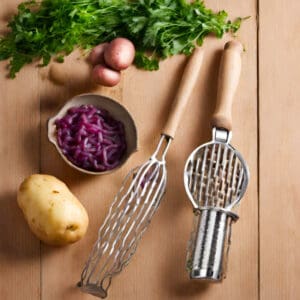
Discover these tricks from an experienced home chef to make your mashed potatoes the envy of every dinner party.
You’ll also learn innovative ways to use your potato masher for more than just potatoes – recipes that will have your family and friends begging you to share more culinary secrets.
KEY TAKEAWAY
How To Use Potato Masher?
Using a potato masher is easy – just peel and boil russet potatoes until tender, drain well, then firmly but gently mash the potatoes with softened butter and warm milk until no lumps remain. Master this basic mashing technique and you’ll be able to create countless hearty comfort foods with your new versatile kitchen tool.
A Guide for Potato Masher
Types of Potato Mashers
There are a few main types of potato mashers used in the kitchen:
1. Traditional Hand Mashers
Traditional hand mashers have a wooden or stainless steelhandle attached to a plate with small holes or tines. They are inexpensive and easy to use. Simply press the masher into the cooked potatoes and maneuver it around to break up the starch.
2. Potato Ricers
A potato ricer has a cylinder with small holes that potatoesare pressed through to create light and fluffy mashed potatoes. Some models have interchangeable plates with different sized holes for varying textures. Ricers produce smooth, smooth mashed potatoes similar to using a food mill or immersion blender.
3. Electric Hand Mixers
For larger batches, an electric hand mixer fitted with a whisk or paddle attachment can quickly mash potatoes. Set the mixer to low speed and slowly increase until the desired consistency is reached. Be careful not to overmix, which will lead to gluey mashed potatoes.
Advantages of Different Types
Each type of masher has advantages depending on the recipe, amount of potatoes, and desired consistency:
- Traditional mashers are inexpensive and don’t require batteries or electrical outlets. They work well for smaller servings.
- Potato ricers produce incredibly smooth, light, and fluffy mashed potatoes similar to those served in restaurants. They take more effort than a masher but produce consistent results.
- Electric mixers are best for large batches. They’re faster than doing it by hand but overmixing is possible. Start slowly and pulse instead of continuous mixing.
Tips for Mashing Potatoes
For smooth mashed potatoes every time, here are some tips:
- Peel russet potatoes and cut into evenly sized pieces for consistent cooking.
- Boil or steam potato pieces until very tender when pierced with a fork.
- Drain potatoes well and return to pan off heat. This allows steam to escape for fluffier potatoes.
- Add warmed milk or cream, butter, and sour cream or garlic and mash using your tool of choice.
- For extra fluffiness, rice potatoes before adding other ingredients.
- Add ingredients gradually until reaching your desired consistency. Loosen with more milk if too thick.
- Don’t overmix once other ingredients are added or potatoes will become gluey. Gentle stirring is best.
- For sweet potato mash, boil or roast halved or quartered sweet potatoes then mash with brown sugar, cinnamon and butter.
With some practice, a potato masher or ricer and these tips will guarantee creamy mashed potatoes every time as a comforting side dish. Experiment with different potato varieties and ingredients to find your family’s favorite mashed potatoes recipe.
Choosing the Right Potato Masher
Material
Potato mashers come in different materials that impact durability and cleaning:
- Stainless steel is durable and dishwasher safe but heavier. Quality stainless steel will last for years with proper cleaning. Avoid cheap steel that rusts easily.
- Wood handles provide a traditional aesthetic but require gentle hand washing. Oils from hands can degrade wood over time.
- Plastic or silicone models clean easily but may stain or break down faster than metal or wood. Check for BPA-free labeling.
Durability
Consider how many potatoes you regularly mash and who will be using the masher. Items used daily need to withstand more wear and tear. Opt for:
- Strong stainless steel construction if making large family-sized batches. Stainless steel lasts well with industrial use.
- Solid wood for periodic home use. Quality hardwood holds up better than cheaper woods prone to cracking or warp.
- Heavy-duty plastic for kids just starting out. Look for reinforced handles that won’t snap from little hands.
Ease of Use
Comfort and ease when mashing is important. Select a masher that:
- Has ergonomic grips for sustained hand positions. Soft, non-slip grips prevent hand fatigue.
- Weighs comfortably without being too heavy. Lightweight eases use for individuals with less upper body strength.
- Features widely spaced or angled tines/holes for free movement through potatoes rather than wrestling the masher.
Price
Consider your needs and budget but avoid the lowest priced items. Cheap mashers use low quality materials that break quickly, negating any savings from an initial low price. Oxo Good Grips and All-Clad rank as top value brands.
Step-by-Step Guide Using a Potato Masher

Prepare the Potatoes
For fluffy mashed potatoes, peel russet potatoes and cut into evenly sized pieces to cook at the same rate. Boil or steam until tender when pierced with a fork.
Drain and Return Potatoes
Drain potato pieces well then quickly return to pan off heat. Letting steam escape creates air pockets for lighter mashed potatoes.
Add Warm Milk and Butter
Add warmed milk in a steady stream while mashing. Then mix in butter until melted. The milk introduces moisture while blending friction from butter results in a silkier texture.
Introduce Sour Cream or Garlic
Mix in sour cream or roasted garlic next. Adding these thicker ingredients after milk and butter avoids lumps. Stir until just combined.
Use Your Masher Effectively
For chunky mash, roughly smash a third of the potatoes then gently mix in. For smoother results, slowly mash all pieces against the pan’s sides with an up-and-down pressing motion.
Reach the Right Consistency
Check the consistency after each addition. Add more milk if too thick or continue to press out lumps. Gentle mixing is best for preventing pasty potatoes. Add seasonings to taste at the end.
Adjust for Sweet Potatoes
Boil or roast halved or quartered sweet potatoes until very soft. Peel if desired before mashing with butter, brown sugar, cinnamon and nutmeg for a rich, seasonal side.
With practice following these steps, any home cook can create fluffy, creamy mashed potatoes worthy of any comfort food spread using just a simple potato masher. (1) Enjoy your homemade mash!
10 Surprising Ways to Use Your Potato Masher
- Crush Cookies: For homemade cookies or brownies, use a masher to crush crunchy leftovers into crumbs for trifles or crusts.
- Make Guacamole: Mash your avocado, lime, salt and other additions for the perfect chunky guacamole texture.
- Blend Salad Dressing: Emulsify vinaigrettes right in the salad bowl using up-and-down masher motions.
- Mix Egg Salad: For a no-mess egg salad , wash and chop hard boiled eggs then gently mash with mayo to your preferred consistency.
- Smash Refried Beans: Press canned or cooked refried beans against the pan to achieve a smooth spreadable texture.
- Blend Hummus: Create homemade garbanzo bean hummus in just minutes by using a masher to mix and crush ingredients.
- Bash Sweet Potato Filling: Puree leftover mashed sweet potatoes with butter and spices for hand pies or tarts.
- Minced Garlic Paste: Create an easy garlic paste or spread by mashing roasted whole cloves.
- Whipped Ricotta: For cannoli filling or pasta dishes, fluff up ricotta using gentle up-and-down masher motions.
- Ground Meat Filling: Partially brown and season ground meat, then mash to the desired consistency for tacos or lasagna.
Why Choose a Potato Masher?
Types of Potato Mashers
There are three main types of potato mashers:
1. Horizontal Mashers
Horizontal potato mashers have a flat plate with holes attached to a handle at a right angle. The plate lays horizontally on the bottom of the pan when mashing.
2. Vertical Mashers
As the name suggests, vertical mashers have a plate attached inline and parallel to the handle. The plate mashes potatoes in an upright position from above.
3. Electric Mashers
Electric mashers feature a rotating head attachment run by batteries or electrical current that mashes potatoes in seconds.
Advantages of Potato Mashers
- Inexpensive: Potato mashers provide affordable and effective mashing with no need for power tools.
- Easy to use: Simply press the flat plater into cooked potatoes a few times until the desired consistency. No learning curve.
- Portable: Lightweight potoato mashers tuck away easily in a drawer and take up little storage space.
- Durable: Sturdy stainless steel or wood construction stands up to years of use without replacement costs.
- Versatile: In addition to mashed potatoes, try mashing beans, salad dressings, or other dishes.
- Traditional: Enjoy the simple satisfaction and nostalgia of mashing potatoes by hand.
For quick, budget-friendly, and versatile mashed potatoes each time, a reliable potato masher remains a worthy addition to any kitchen tool collection. With a bit of practice, gorgeous homemade mashed potatoes will become effortless to prepare.
Potato Masher Recipes and Inspirations

Mashing ingredients to the right texture is key for these delicious recipes. With a little practice and the right potato masher, you’ll be creating mouthwatering dishes in no time!
- Thick and Hearty Tomato Stew: Fire roasted tomatoes crushed with a masher thicken this comforting stew. Savory onions and spices nestle in a backdrop of soft mashed potatoes. Serve with warm tortillas on a cold night.
- Fruit Waters to Quench your Thirst: On a hot summer day, nothing refreshes better than homemade agua fresca. Gently mash sweet melons and berries with a splash of simple syrup, then strain for a fruity, fizzy drink the whole family will love.
- Smooth and Creamy Yogurt: Whisking buttermilk into homemade yogurt and carefully mashing makes for the perfect smooth and protein-packed breakfast. Top with crunchy granola and fresh fruit for an energizing start to your day.
- Fluffy Scrambled Eggs: For scrambled eggs with an extra indulgent texture, lightly crush the yolks before cooking. A few presses of the masher incorporates air pockets that result in light and fluffy scrambled eggs every time.
- Layered Salad Dip: Create this colorful layered dip by alternating strata of guacamole, pico de gallo and sour cream. A few strategic mashes ensures the flavors blend but remain distinct – perfect for parties or weeknight meals.
Get creative in your kitchen using versatile tools like a potato masher! Experimenting with different ingredients unlocks new recipe ideas.
Conclusion
Whether making creamy mashed potatoes or another dish, a few simple tips ensure tasty results.
Using russet or yukon gold potatoes leads to light and fluffy textures. Cutting potatoes uniformly and draining them thoroughly prevents lumps from forming. Adding warm milk and softened butter gradually eliminates clumps. A ricer produces silky smoothness, though requires more effort. Dishwasher-safe masher models clean easily. Letting them dry fully protects against rust in the drawer. Practice choosing the best potato varieties and cutting them evenly.
Follow tips for adding ingredients and mashing till no lumps remain. With these techniques, cooks can craft many tasty foods with just a basic potato masher.
Frequently Asked Questions
How to achieve light and fluffy mashed potatoes?
The best potatoes to use for light and fluffy mash potatoes are russet or yukon gold potatoes. Peel the potatoes and cut into uniform sizes pieces before boiling until very tender. Drain the potatoes well and return to the pot off heat to allow steam to escape which creates air pockets. Add warmed milk or cream and mash with a potato masher or ricer. Avoid over-mixing which can cause the potatoes to become gluey.
What’s the best way to store a potato masher?
For convenient storage, potato mashers with stainless steel or wood handles can be placed in a drawer in the kitchen. (2) Make sure it is thoroughly dried after each use to prevent rusting or mold growth. potato mashers with plastic or silicone handles can also be stored in a drawer and are easy to clean in the dishwasher.
How do I clean a clad stainless steel or OXO Good Grips potato masher?
Stainless steel and OXO Good Grips potatoe mashers are dishwasher safe for easy cleaning. Make sure to remove any lingering food particles first by rinsing under running water. Place on the top rack of the dishwasher away from the heating element and heirloom dishes. For hand washing, a mild soap and warm water will suffice. Dry thoroughly to prevent rust spots from forming. Do not soak in bleach or place in the microwave.
What is the best potato variety for mashed potatoes?
Russet and Yukon Gold potatoes generally produce creamiest, smoothest mashed potatoes. Russets have a very starchy interior that results in light and fluffy mashed potatoes. Yukon Golds have a bit of waxiness to them and make rich, creamy mashed potatoes. Both varieties are widely available in supermarkets. New potatoes can also be used for a chunkier texture. Avoid waxy varieties like red potatoes which tend to become gluey when over mixed.
How do I prevent lumps when making mashed potatoes?
To prevent lumpy mashed potatoes, make sure to peel potatoes uniformly and cut into evenly sized pieces for consistent cooking. Drain the potato pieces well before adding ingredients and mashing with a ricer, masher or mixer. Add softened butter and milk gradually in portions while mashing. Avoid overworking the potatoes which can cause them to become starchy and lumpy. For extra silky texture, pass potatoes through a ricer or food mill before mixing in other ingredients.
Our Latest Post:
💻 Spider Strainer | Food Dehydrator | Blender
Was this helpful?
Hi there! I’m a food enthusiast and journalist, and I have a real passion for food that goes beyond the kitchen. I love my dream job and I’m lucky enough to be able to share my knowledge with readers of several large media outlets. My specialty is writing engaging food-related content, and I take pride in being able to connect with my audience. I’m known for my creativity in the kitchen, and I’m confident that I can be the perfect guide for anyone looking to take their culinary journey to the next level.








